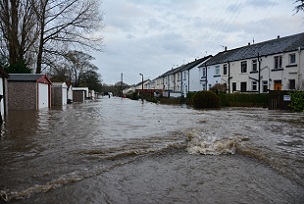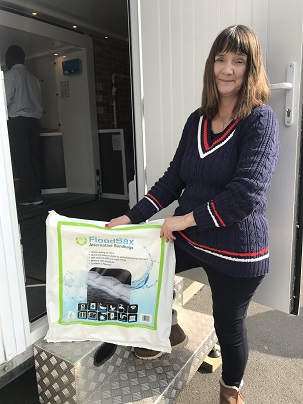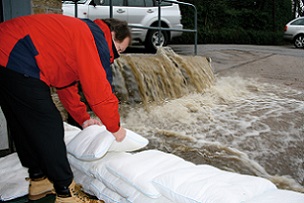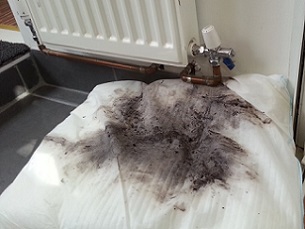 Flooding is a miserable experience and will only get worse due to climate change
Flooding is a miserable experience and will only get worse due to climate change
 Flood campaigner Mary Dhonau with a pack of FloodSax alternative sandbags
Flood campaigner Mary Dhonau with a pack of FloodSax alternative sandbags
 FloodSax keeping a torrent of floodwater out of a business
FloodSax keeping a torrent of floodwater out of a business
 FloodSax sandless sandbags are also highly effective at soaking up internal leaks, drips, spills and floods
FloodSax sandless sandbags are also highly effective at soaking up internal leaks, drips, spills and floods
How FloodSax alternative sandbags can be a vital part of Flood Re’s Build Back Better scheme
Major insurance companies are now giving customers who have been flooded up to £10,000 to help flood-proof their homes or businesses to protect them in the future.
The cash windfall is above and beyond the cost of any damage repairs and is designed to make their properties more flood resilient and is the first scheme of its kind in the world.
It’s called Build Back Better and has been devised by Flood Re, the joint initiative between the UK insurance industry and the UK Government to promote the availability and affordability of flood insurance, especially to homeowners who have been flooded before.
Five major insurance companies are the first to sign up to the scheme from the beginning of April and they are NFU Mutual, Aviva, Ageas, Lloyds Banking Group (Bank of Scotland, Halifax and Lloyds Bank home insurance products) and LV= General Insurance.
But what is the ultimate flood resilience package?
Well, it’s this according to flood expert Mary Dhonau who is affectionately known as Mary, Queen of Floods.
A flood victim turned flood crusader, she’s now the ‘go to’ expert on flooding and is often touring the country in her floodmobile showing people the best ways to prevent flooding in the first place and also what can be done inside your home or business to stop damage should floodwater get in.
And she has shared her ultimate flooding prevention 1, 2, 3.
Step 1: Have a specialist flood door to prevent the water getting in but be aware that most doors won’t stop all the water from seeping through.
Step 2: Put FloodSax alternative sandbags on the floor inside the door to soak up any water that does get in. In their dry state, FloodSax are ultra-thin with a large surface area so are ideal at absorbing any floodwater, especially in hard-to-reach places.
Step 3: Invest in a portable water pump to get rid of the water quickly down to 1mm … and then use FloodSax (http://www.floodsax.co.uk/) again to soak the rest up.
Mary said: “To get the flooding kite mark, anti-flood devices must not leak more than a litre of water in an hour.”
This means that water can and does leak in through many anti-flood devices.
FloodSax are well-known as alternative sandbags – just immerse them in water and they expand to act like traditional sandbags – but in their dry state they are great at soaking up water from leaks, spills and floods indoors.
The fact that they can be used both indoors and outdoors makes them one of the most flexible anti-flood devices on the market.
Other ways to Build Back Better after flooding include non-return valves in pipes, raising electrical sockets away from the floor, self-closing air brick covers, waterproof flooring and an ingenious cavity membrane system to stop water coming through the walls.
People given Build Back Better money don’t just have to use it for flood resilience measures, they can also spend it on surveys to understand the flood risk and potential mitigation.
Flood Re chief executive Andy Bord said: “In the UK since 1998 we have seen six of the wettest years on record with 5.2 million homes and businesses at risk of flooding. The trajectory will only continue to worsen without urgent, collective action – there is no time to waste. It is vital we encourage and incentivise adaptation among homeowners.
“The insurance industry has an opportunity to show its innovation and responsiveness to consumer need and to make real, tangible change. But to do so we must throw the traditional principles of insurance to one side. This means thinking of future resilience and building back better after a flood, rather than simply returning a property to how it was before.
“It’s hugely encouraging that five insurers have already partnered with us to offer Build Back Better provisions to customers and I am encouraged that, together with insurers soon to join, we will truly make a difference.”
Martin Milliner, claims director at LV= General Insurance, said: “Flooding is an extremely traumatic event which has a devasting impact on a person’s life, both physically and mentally. It’s therefore crucial that we look into how homes can become more resilient to reduce the impact of future flooding and help customers return to their homes more quickly after a flood.”
Flooding victim David Hegarty from Bewdley in Worcestershire said: “It strikes me that if you flood and you have a lot of damage it’s ridiculous to just put everything back to how it was before.
“If those lessons have been learned and you can improve your home environment, make it more resilient and safer, why wouldn’t you? One of the only reasons I can think of is not being able to afford the adaptation measures. If there is a process that will enable people to make their homes more resilient based on the lessons learned from a flood, I think that’s a great idea.”
For more information on Flood Re go to https://www.floodre.co.uk/